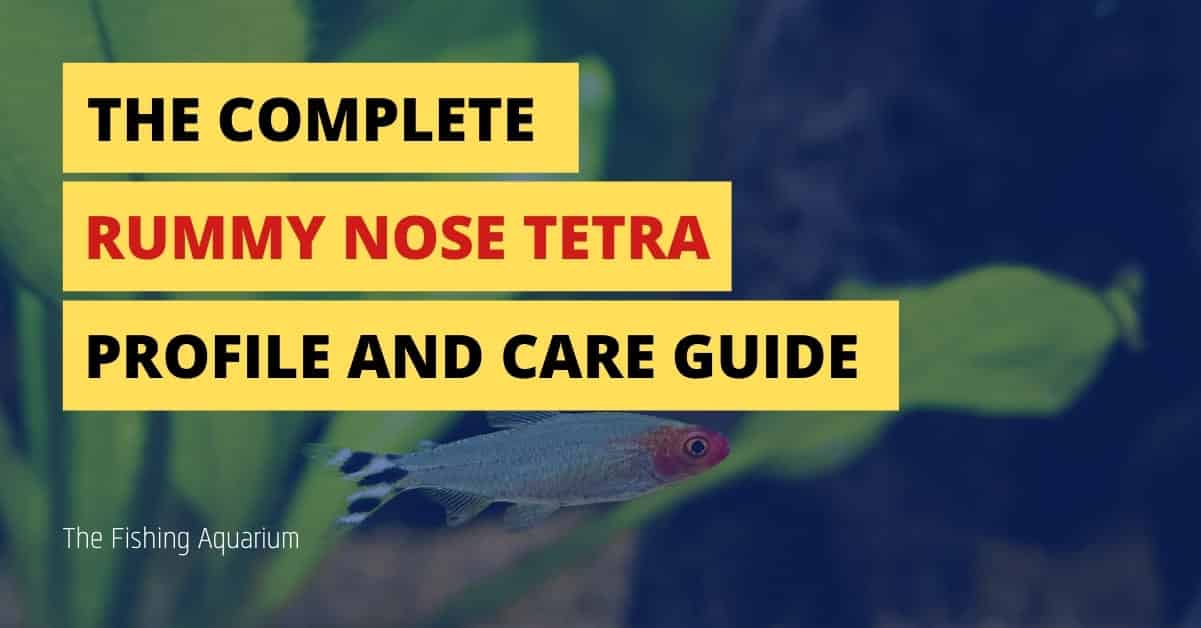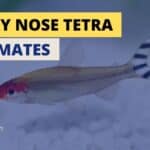Rummy nose tetras are one of the most popular fish in the aquarium hobby.
These attractive little fish comprise a significant segment of many people’s aquariums. They can be found in pet stores all over the world and they are usually available for purchase online as well.
As rummy nose tetra popularity continues to grow, so does the demand for information about their care requirements and other aspects of their lives.
This article will provide you with everything you need to know about rummy nose tetras, from what they eat to how big they get!
Contents
- Rummy Nose Tetra Fish – Overview
- Rummy Nose Tetra Care & Things To Know
- The Right Aquascaping Ideas For Rummy Nose Tetra
- End Of The Article
Rummy Nose Tetra Fish – Overview
Rummy nose tetra fish is a species of freshwater tropical fish native to the Amazon basin.
They belong to the Characin family and they typically reach about four inches in length when fully grown.
Rummy nose tetras are also known as the rummy noses, bristlemouths, or bristle noses because their mouth contains an amazing number of fine teeth at the front (around 100 on each side!).
This is one-way rummy nose tetras distinguish themselves from other types of characins – most members of this family have fewer than 50!
Rummy Nose Tetra Care & Things To Know
Natural Habitat
We will start with rummy nose tetra natural habitat. They originate from Central and South America, so they should be kept in water temperatures between 22-26 degrees Celsius.
Their native range is the Amazon basin, but rummy nose tetras have been successfully introduced to several other regions of the world as well!
Rummy nose tetras can grow up to four inches long or more depending on how often you feed them and how many rummy noses are housed together in a single tank.
However, it’s not uncommon for rummies to live less than two years because their care requirements are still relatively new compared to some fish that have lived over twenty years under aquarium conditions!
Rummy nose tetra is usually found at the bottom of a lake or stream, but can also live in murky water near ponds. They have been seen living between two to four feet deep with only sunlight entering from above on occasion during daytime hours and because of this rummy is a nocturnal fish.
Rummy nose tetras are not community fish and should be kept in solitary tanks only. But, can occasionally be introduced to the same species with caution before adding them into the tank together if they seem friendly enough.
Appearance and Size
The rummy nose tetra is a relatively small fish, with the males being smaller than females.
They have an average length of about two to three inches and can be found in various colors like gold, silver blue, or green.
However, most rummy nose tetras are red-ish brown coloration which makes them easy to identify as rummy nose tetras.
Rummy noses have a lifespan of about four years and are one of the more popular and well-known fish in an aquarium.
Why is my rummy nose tetra losing colour?
It is common for rummy nose tetra fish to lose color. This may be due to several reasons like, the water quality isn’t that great or there are too many competing tank mates in the aquarium. There might also be an imbalance in the rummy nose tetra diet which can lead them towards losing their natural colorful skin coloring and become much paler than usual.
A bacterial infection could also cause this condition among other things. The best remedy for any problem with rummy nose tetras is by consulting your local pet store as they will likely have expertise on what would work well out of all available options you may have considered so far.
Why my rummy nose tetra lost tail?
The rummy nose tetra tail is a part of their lateral line system. This sensory organ helps rummy nose tetras to sense movement in the water, but also for them to navigate through it and find food sources too.
In some cases where there are no other signs or symptoms noticed by you as an owner, your rummy nose tetra might have just lost its tail due to natural wear and tear day-to-day living inside the aquarium tank which has resulted from the fish rubbing against rocks and objects in the landscape or if they were born without one because that particular gene was not passed on.
If this is indeed what’s happening with your rummy nose tetra then all you need do now is buy another new rummy nose tetra tail fin with the same size, shape, and color from your pet shop to replace it.
Why my rummy nose tetra has white spots?
A rummy nose tetra with white spots is most likely an albino rummy nose tetra. It probably got its genes from both parents who had a recessive gene for this trait and passed it on to their offspring. This can happen when the fish’s natural habitat has been disturbed or polluted, thereby compromising its immune system and leaving it open to attack by parasites that cause these sorts of defects in coloring. These white spots are usually harmless but if you’re concerned about them then an expert should be consulted before continuing any treatments.
Why are my rummy nose tetras pale?
The reason your rummy nose tetras are pale is that they are most likely albino rummy nose tetra. The rummy nose tetra is a fish that gets its genes from both parents who have a recessive gene for this trait, in which case the white spots on their scales and fins are harmless but if you’re concerned about them then it’s best to consult with experts before doing anything else.
Can Tetras regrow their tails?
Tetras can regrow their tails if they have a severe injury or lose it due to age. Tetra’s fins are very sensitive and so rummy nose tetras might not be the best pet for children as they could inadvertently injure them without even realizing that what they’re doing is wrong.
Lifespan
The average lifespan of rummy nose tetra fishes is three to five years.
Many fishkeepers say that rummy nose tetras are one of the hardiest fish they have. The better you feed your tetra the more they live in the tank.
We will be also discussing the right feeding to your rummy nose tetra in a different section here.
The thing which will help you to grow your tetra’s lifespan is to keep them in a clean tank and feed them regularly.
Temperament & General Behaviour
The Rummy nose tetra is a peaceful fish that can be kept in an aquarium with most other freshwater community fish.
They are considered to be very active and would need plenty of room for swimming which should not exceed fifty gallons per rummy nose tetra, as well as hiding places such as live plants or rocks.
It’s best if you have them by themselves because they may bully others who are smaller than them.
Rummy noses have a lifespan of about four years and are one of the more popular and well-known fish in an aquarium; rummies tend to get along better with each other when living alone so there isn’t any unnecessary bullying going on between different individuals within their species
Rummy nose tetras like to eat almost anything that is offered to them. They also prefer vegetable matter over meat. They will accept flakes, frozen food, or live foods such as worms or brine shrimp.
They are generally community fish and can be kept with other species as long as the tank has enough space for both.
School/Community
Rummy nose tetra are schooling fish and they should be kept in groups of at least six.
They form shoals which is why they are also called rummy nose tetras, rummy nosed tetras, or common rummy noses.
A group of Rummy nose tetra fishes tank mates can include other species such as barbs, guppies, mollies, etc.
Rummy Nose Tetra has a high tolerance for different water conditions and temperature fluctuations, unlike some other tropical freshwater aquarium fish breeds that require an unchanging environment to thrive in similar to how the betta requires warm stagnant water without any current or movement whatsoever.
Feeding
The right food for rummy nose tetra includes bloodworms, brine shrimp, eggs, and some types of algae.
Bloodworms are rummy nose tetra’s favorite food in the wild. They will eat blood worms very eagerly.
Eggs can be a good option to feed rummy nose tetras but they should not be their primary source of nutrition because this is unhealthy for them in the long term as well as expensive.
Brine shrimp are another great choice to add to your diet if you want something that has protein since it has high levels of amino acids which make up proteins like every other animal needs them too including humans (and rummy nose tetras).
Algae also contain minerals such as calcium and magnesium that will help balance out all the nutrients they will need for their diet.
If you are looking to feed rummy nose tetra fish live food, then cichlid pellets might be a good option. Make sure that they are not made of any animal origin and instead look for those which have vegetable proteins in them.
Remember to watch your rummy nose tetras though when feeding them different types of foods as it can cause stomach problems or even poisoning if the wrong kind is given.
What NOT To Feed Rummy Nose Tetra
Many rummy nose tetra enthusiasts feed their rummy nose tetras live food such as worms, insects, and small fish.
If you are feeding your rummy nose tetra these types of foods regularly watch out for any type of scratches or abrasions to the skin.
Some people believe that this could lead to infections in other parts of the body including mouth sores; therefore it is important not to overfeed them with live prey items.
The other thing you should not be feeding is any type of food that is high in mercury levels.
Mercury can be found in a lot of the foods we eat and as well as from pollution, so it’s important to know if you have any items with an unsafe amount of mercury when planning rummy nose tetra food selections.
Water Temperature/Parameters
Checking your water temperature or parameters is a must thing.
If the rummy nose tetra is too cold, they will not thrive. If their water parameters are off balance and/or have a bad pH level there will be an unhealthy environment for rummy nose tetras.
Water Parameters: Right parameter one should keep in the tank for rummy nose tetra is 50-60 degrees Fahrenheit.
pH Level: The ideal range of pH is between six to eight; however, rummy nose tetra can withstand fluctuating levels that are higher than this.
The right PH should also include the nitrogen compounds in nitrates or phosphates which measure 0-50 ppm (parts per million).
Nitrates are produced by plant life as well as from uneaten fish food, while phosphates come mainly from tap water and minerals dissolved in it such as calcium phosphate. A high amount of nitrates and phosphates can cause illness to rummy nose tetra.
Temperature: The ideal range of water temperature is 68-78 degrees Fahrenheit. Too much or too little heat in the tank will make rummy nose tetras uncomfortable, which may lead them to stop eating.
If a rummy nose tetra cannot swim away from the side of an aquarium that has been heated by either lamps or other equipment then it could die due to overheating.
Swimming Level
Rummy nose tetra is a mid-level swimmer that swims horizontally.
They are usually found at the bottom of the tank and swim up to grab food from higher waters, but they also like to go inside plants for cover.
The rummy nose tetra is a schooling fish and thrives when kept in groups of five or more.
They are active swimmers, so you should provide plenty of space for them to swim about.
The rummy nose tetra needs at least 30 gallons per juvenile fish and 50-75 gallons per adult rummy nose tetras that measure 12 inches (30 centimeters) long.
So if they have enough swimming room, then the rummy nose tetras will be fine living with other community species such as guppies, neon tetras, Corydoras catfish, and rainbow sharks.
Breeding/Spawning
To successfully breed rummy nose tetra, the water temperature should be kept at or above 77 degrees Fahrenheit.
The females will lay their eggs on both live plants and fake ones alike.
One of the best ways for breeding rummy nose tetra is by using a breeder net that has an area in it with a slow current so the female can release her eggs into this section which allows them to hatch without being carried away from it where they are released.
Breeding Methods And Techniques: To get rummy nose tetras spawning (breeding) one must provide all of their needs such as proper food, clean water, and tank mates.
If you provide rummy nose tetras with a large enough aquarium, they will most likely spawn (breed) and lay eggs for as long as their water parameters are maintained.
How to correctly breed one male and female rummy nose tetra?
Fertilization Process: A rummy nose tetra will release its eggs into an area of slow current for them to hatch without getting carried away from where they were released.
The Female Rummy Nose Tetra Fish: First inflate their swim bladder by taking air from it with your mouth or use very gently teeth on side of the body near tail base until you see abdomen (similar as blowing up a latex balloon) round out; then carefully place a hand under female rummy nose tetra’s belly at the front end just behind her pelvic fins and press rummy nose tetra’s body against your palm to release her eggs.
The Male Rummy Nose Tetras: His job is to fertilize the female rummy nose tetra by flaring his nostrils and releasing sperm while she releases her eggs. He does not need to touch her for this process to happen because of how close their bodies are located.
Eggs Hatch after two days if conditions are right, then they will sink to the bottom where they would be safe from being eaten or dispersed in currents; They can hatch anywhere between 40 minutes to a few hours depending on the temperature of the water, but usually happens within 24 hours.
Tankmates
Rummy nose tetra is not suitable for tank mates for other fish because rummy nose tetras can only be kept in a group of at least six individuals.
It is very important to keep rummy nose tetras with their kind because they will become stressed if placed in the wrong environment.
They like quiet environments and low light levels, so it is best to place them towards the bottom or back of your aquarium where there isn’t as much activity going on.
Remember that rummy nose tetras prefer soft water conditions, so do some research before adding them to an otherwise well-established community tank!
For making your research easy we came up with a list of the best rummy nose tetra tank mates that will do well in the same.
Here is the list:
Red Clownfish
Red clownfish and rummy nose tetra work great together because they both prefer the same tank conditions and will not disturb each other.
Honey Gourami
Honey gouramis are a good rummy nose tetra tank mate that you can try out, as long as you provide them with enough space to swim freely. The honey gourami is an algae eater, which means it’ll help keep your rummy nose tetras well-fed in-between meal times!
Pygmy Corydoras Catfish
Pygmy corydoras catfish are another rummy nose tetra’s best friend for these reasons: pygmies like small spaces so they won’t bother rummies; their delicate fins make them very gentle on smaller fish, and they are good at keeping the tank clean.
Bristlenose Pleco
The Bristlenose pleco is a rummy nose tetra’s best friend because it will eat algae from their skin, which can sometimes grow around rummies’ mouths in a process known as “algae beard.” The Bristlenose plecos also don’t need much space to swim about so you’ll be able to keep them together without any problems!
African Dwarf Frogs or Tadpoles
African dwarf frogs (or tadpoles) make for great rummy nose tetra friends, but only if there is enough room in your aquarium for both frogfish. These little guys love perching on top of plants and will provide rummy nose tetra with the company they need.
Neon Tetras
Neon tetras are a good rummy nose tetra friend because they like to swim in schools and enjoy being around other fish, just like rummies do!
Black Mollies or Guppies
Black mollies (or guppies) have large fins which will give rummy nose tetras more room to move about when it’s time for them to school up together in groups of ten.
Dwarf Cichlids or Angelfish
Dwarf cichlids (or angelfish) make great friends for rummies because their peaceful nature means that you can keep some other aggressive rummy nose tetra species in the tank with them.
African Cichlids or Discus Fish
African cichlids (or discus fish) are rummies’ best friends because they’re just as peaceful and don’t mind following rummies into tight areas of their tanks.
Siamese Algae Eater
Siamese algae eaters provide a rummy nose tetra with great company, but there’s one caveat: you will need to feed these fish on an alternate day cycle! They can get outcompeted by other more hungry fishes if they have access to food all the time.
Corydoras Catfish
Corydoras catfishes are rummies’ best tank mates and friends because they’re just as tolerant of eggs, fry (baby rummy nose tetras), or other fish. Corys also enjoy roaming around in the gravel on their bellies to find treats!
Plecostomus Fish
Plecos make for great rummy companions and helpers too–they love eating algae off the glass of most tanks, so this means less work for you! Plus, these bottom feeders help keep your substrate clean by pulling out waste that sinks to the bottom of your tank. Just be sure not to put two plecos together…these territorial suckers will fight like crazy!
Tetra Fish
Other rummy nose tetras are easy to find and inexpensive, so it’s best to keep your rummy in a school of at least five or six.
ALERT: Please be sure to make your research before adding any other fish so that you know which ones will work best with their environment. It is also important for the rummy nose tetra tank mates to not have a different pH, temperature, or hardness than the rummy. This can cause stress in them as well!
If you are unsure about what these things mean – don’t worry we have included some links below of each topic and more detail on it. These should help provide all the information needed when considering new additions to your aquarium!
NOTE: We also wrote an article on best rummy nose tetra tank mates, please check out that too.
Rummy Nose Tetra’s Egg & Fry Care
Rummy nose tetra eggs and fry care is a very sensitive topic. It is crucial to make sure the rummy nose tetra eggs are not attacked by fungus or other external microbial that might harm them. There are few ways of keeping rummy fish babies safe from picking up any disease from their environment, which includes using the chemical treatment for slime mold prevention in new tanks, filtration systems as well as avoiding overcrowding. Another important factor to keep in mind when breeding rummy nose tetras is constructing an area where they can spawn and going through the process without harming one another’s fins or tails with sharp objects like gravels under your water flow control valve.
Make sure you have a separate room or container in the same tank for eggs which will help the process to go on smoothly.
Common Possible Rummy Nose Tetra Disease & Cure
Rummy nose tetra can suffer from Parasites, Ich, or even Velvet.
Parasites are usually cured with a medication such as metronidazole and will need to be treated for about two weeks before the rummy nose tetras will start behaving normally again.
Velvet is caused when there isn’t enough space in your tank or if you’re not feeding them properly – this can also be cured by adding more plants to their environment!
Ich might sound like it’s just an abbreviation but stands for “Ichthyophthirius multi-files” – these little guys love living on fish scales so what happens next is that they feed off of blood cells and eventually kill the rummy nose tetra leaving them looking like little zombie fish.
The Right Aquascaping Ideas For Rummy Nose Tetra
So, from here we will be discussing the right care guide for rummy nose tetra. Because I am sure now at this point you may be thinking of rummy nose tetra as your next aquarium pet or addition.
PRO TIP: We have rummy nose tetra alongside other species with the aquariums. In that case, it is a good idea to know how they can co-exist in your tank together. You should not put rummy nose tetras and aggressive fish together as rummy noses may be harmed by these aggressors due to their timid nature (not everyone has experience keeping them). An example of this combination would be rummy-nosed tetra along with tiger barbs or cardinal tetras. On the contrary, you can also combine rummy nose red tail sharks with yellow-tailed black shark-like crimson devils for an interesting contrast of colors!
Tank Size
The right tank size for rummy nose tetra should be at least 20 gallons (75 L), including the size of the water change. The rummy nose tetras need space to swim in, so a small tank is not suitable for them. However, the rummy nose tetra tank should not be overcrowded.
The rummy nose tetra is a schooling fish and so they need to live in groups of at least six fishes per aquarium. So it’s best if you have two rummy nose tetra tanks with three or four rummy nose tetras each, that will provide enough space for them to swim around and also keep their social interactions going well.
Water Conditions and Temperature
As we discussed earlier in this post, rummy nose tetra thrives in water that is soft to moderately hard, acidic, and between 72-78 degrees Fahrenheit.
Just like any other fish, rummy nose tetras should be acclimated slowly so they can adjust to the changes in pH and hardness levels gradually which will prevent shock or death.
Lighting/Heating
Rummy Nose Tetra is tropical fish which means they can only live in waters at temperatures of around 84°F or higher. These tetras will not thrive when the temperature is below 74°F so it’s important to maintain water temperatures between these two numbers as much as possible. The rummy nose tetra tank should be placed where there is enough natural sunlight coming through for their needs and also with no drafts affecting the water temperature.
The rummy nose tetra requires sunshine all day long but is never close to direct contact with them, this causes too high temperatures making the rummy nose tetra more vulnerable to disease. You may need an aquarium heater if you’re living in cooler climates, though please note that rummy nose tetra is sensitive to rapid changes in water temperature so don’t turn the heater up too much.
Filtration
The rummy nose tetra requires a lot of work when it comes to filtration. They need constant water changes, clean filters, and regularly cleaned aquariums or tanks. The rummy nose will release ammonia into the tank as they excrete their waste which is why you have to change the water so often with them for there not to be an ammonia spike within your fish’s environment. It may seem like a lot of work but if you maintain these processes then your rummy nose tetras will live long happy lives!
If you’re using a filter, rummy nose tetra prefers filters that are cycled tanks with medium and large-sized fish inside of them as rummy noses love living among plants and other hiding spaces for cover. The rummy nose tetra tank should also be decorated with different types of rocks or gravel because these provide nutrients for growing algae which is beneficial for rummy noses!
Suitable Plants
The most important thing when setting up your new home for rummy nose’s enjoyment is choosing plants. You should find plants that will not harm rummy nose tetra and also don’t have any sharp edges or spines on them so they won’t hurt your fishes’ sensitive skin when rummaging around.
This includes Java moss, Anubias, Java ferns, Hair grasses (which are perfect for the bottom of a tank), rhododendron leaves, and many more!
Java Moss – Java moss is easy to care for and will not harm rummy nose tetra. It’s a no-brainer pick when it comes to rummy nose tetras because of how simple the plant is to maintain, but also because rummy noses love this stuff! Java moss provides your rummies with plenty of places they can explore so that they don’t feel bored or stressed in their environment.
Anubias – Anubias are another great option when deciding on plants for your rummy nose tank. They grow slowly which means you won’t have an overgrowth situation happening anytime soon (or ever!), and since these are bigger plants than java moss, there will be more room for rummy to play around if need be!
Anacharis – Anacharis or Elodea canadensis is another great option for rummy nose tanks. Not only are they one of the most popular types of plants to keep in fish tanks because they grow quickly and cover a large area, but rummy love them too! They provide your fishes with plenty of hiding spaces when needed.
Java Ferns – Java Ferns are a popular type of plant to keep in rummy nose tanks as well. These plants grow quickly, and they also provide rummy with plenty of great hiding spaces.
Hair Grasses – Rummy nose tetra loves hair grasses in the rummy nose tank. It is a great plant that grows quickly and rummy also loves to hide in the grasses when they feel scared or threatened by other types of fish.
Anacharis, Java Ferns, Hair Grasses, and Java Moss are all popular plants rummy owners like to keep in their tanks because they provide both excellent live space and give rummy plenty of places to hide from time to time!
Substrate
The ideal substrate would have gravel on the bottom mixed in sand, it provides excellent surface area and enables burrowing while maintaining suitable oxygen levels. As well, live aquarium plants like java moss will work great since they can grow into any shape and provide rummy nose tetra with some shade, and the extra surface area will help maintain oxygen levels.
I used a mixture of crushed coral, river pebbles, and sand. I had rummy nose tetra in my community tank for about two years before adding them to their new home with this substrate. They quickly adjusted to the change in environment and adapted very well.
Final Thing
The final thing you should know about rummy nose tetra is that they are not a particularly easy fish to care for. They do need live plants in their tank and prefer some shade, which means they will do best with other small schooling fish or peaceful community dwellers rather than aggressive larger ones.
Rumour has it that rummy nose tetras can be difficult to breed, but this isn’t true if you follow the one key rule of breeding them: keep your water clean! Your rummy nose tetra’s health and lifespan depend on how well maintained their environment is, so keeping these conditions perfect for as long as possible should always be your goal when caring for rummy nose tetra.
The most common way people find out about rummy-nosed tetra disease is when they notice their rummy nose tetras start to get pale and lethargic. This also often means the rummy nose tetra has an infection, so you’ll want to bring your rummy-nosed tetra fish immediately into a quarantine tank where it can be treated with medications like antibiotics or salt baths.
But if you keep your water clean, there’s not much for rummy nose tetras that could go wrong!
If these conditions are met then this should maintain a healthy rummy nose tetra population in any aquarium space.
End Of The Article
Rummy nose tetra is one of the most popular fish in aquariums due to its attractive appearance and peaceful behavior. These little guys can also live for 3-5 years, making them perfect schooling fish that will keep your tank lively without being too aggressive or territorial. They’re a great choice if you have younger kids who want to be involved with caring for an animal but might not be ready for larger more active species like goldfish.
Loving rummy nose tetra? Tell us in the comment section. You can also read more tetra profiles here.
Happy fishkeeping!
You might be interested in reading other tetra fishes profiles, So we have you covered.
- black neon tetra
- congo tetra
- black skirt tetra
- white skirt tetra
- glofish tetra
- glowlight tetra
- green neon tetra







